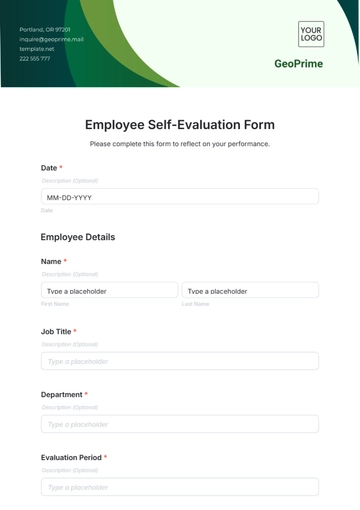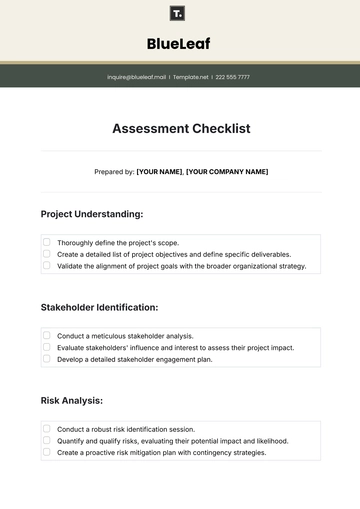Free Professional Economic Risk Assessment

Project/Investment Title: Global Green Energy Expansion Project
Date: January 15, 2080
Prepared By: [Your Company Name]
Reviewed By: Dr. Laura H. Franklin, Chief Economist, EcoTech Solutions Inc.
1. Executive Summary
Overview of the Project/Investment:
EcoTech Solutions Inc. is initiating a global expansion project focusing on renewable energy technologies, including solar, wind, and geothermal power, to serve emerging markets. The project aims to install 500 megawatts of renewable energy infrastructure over the next five years in South America, Africa, and Southeast Asia.
The objective of the Risk Assessment:
This assessment evaluates the potential economic risks associated with global economic conditions, market dynamics, and regional challenges, which may impact the project's execution, costs, and returns on investment.
2. Economic Environment Analysis
Market Overview:
As of January 2080, global economic growth is projected at 3.2%, with inflation rates hovering around 2.5%. Emerging markets are seeing accelerated growth due to a shift towards sustainable energy. However, geopolitical tensions and supply chain disruptions remain concerns. Global energy demand is expected to grow by 4.7% annually over the next decade, creating significant opportunities for renewable energy investments.
Industry Trends:
The renewable energy sector is witnessing rapid advancements, including the development of next-generation solar panels and more efficient energy storage solutions. Governments worldwide are also increasing investments in green technologies, supported by new climate change agreements. However, regulatory uncertainties in specific countries could affect the pace of the industry's growth.
Economic Indicators:
GDP Growth: 3.2% globally, with higher growth in target regions (South America: 5.1%, Africa: 6.3%, Southeast Asia: 4.5%).
Inflation: 2.5% globally.
Interest Rates: 3.5% in major markets (U.S., EU, Japan), higher in emerging markets (7.8% in South America, 9.2% in Africa).
Currency Exchange Rates: Volatile exchange rates, particularly between USD and regional currencies, may impact project costs.
3. Identification of Economic Risks
Risk Category:
Political Risk: Changes in government policies or instability in emerging markets (South America and Africa) may disrupt project timelines and financing.
Regulatory Risk: Uncertainty around renewable energy incentives and tariffs in Southeast Asia, particularly in Vietnam and Indonesia.
Market Risk: Increased competition from local renewable energy producers and fluctuating commodity prices (such as raw materials for wind turbines and solar panels).
Credit Risk: Risk of delayed or reduced financing due to tightening credit conditions in emerging markets.
Currency/Exchange Rate Risk: Volatility in exchange rates could increase capital expenditure costs in foreign markets.
Inflation/Deflation Risk: Rising inflation in emerging markets may lead to higher operational costs.
Supply Chain Risk: Disruptions in the global supply chain for renewable energy components due to geopolitical tensions or natural disasters.
4. Risk Impact Analysis
Impact on Financial Performance:
Political instability in South America could result in project delays, potentially increasing costs by 15-20%. Regulatory changes in Southeast Asia could lead to higher tariff costs, reducing profit margins by 5%.
Fluctuations in commodity prices (such as copper for solar panels) may increase raw material costs by up to 10%, which could impact the overall profitability of the project.
Currency depreciation in regions like Africa could result in an additional 5% cost burden for financing in local currencies.
Likelihood of Occurrence:
Political Risk: Medium
Regulatory Risk: High in Southeast Asia, Medium in South America and Africa.
Market Risk: Medium
Credit Risk: Medium
Currency/Exchange Rate Risk: High
Inflation/Deflation Risk: Medium
Supply Chain Risk: High due to global trade disruptions.
Severity of Impact:
Political Risk: Major (due to potential project delays and legal complications).
Regulatory Risk: Moderate (affecting costs but manageable with mitigation strategies).
Market Risk: Moderate (competitive pressures could reduce expected margins).
Credit Risk: Moderate (possible funding delays or reduced terms).
Currency/Exchange Rate Risk: Major (high risk of cost escalation).
Inflation/Deflation Risk: Moderate (affects operational costs).
Supply Chain Risk: Major (severe disruptions could cause project delays).
5. Risk Mitigation Strategies
Mitigation Actions:
Political Risk: Engage in proactive lobbying with local governments and build strategic partnerships with local authorities. Develop political risk insurance policies to mitigate potential losses.
Regulatory Risk: Work closely with local regulators to understand policy shifts. Develop flexible contract structures that account for tariff changes.
Market Risk: Diversify supply chains by establishing contracts with multiple suppliers in different regions to avoid reliance on a single source. Continuously monitor the competitive landscape to adapt pricing strategies.
Credit Risk: Secure early-stage funding through international development banks or impact investors. Establish flexible financing terms with creditors to mitigate tightening credit.
Currency/Exchange Rate Risk: Use hedging strategies to lock in exchange rates for key transactions. Maintain a balance between local and foreign currency financing to reduce exposure.
Inflation Risk: Include cost escalation clauses in contracts with suppliers and contractors. Monitor inflation trends and adjust budgets accordingly.
Supply Chain Risk: Build buffer inventories for critical components. Establish contingency suppliers and maintain strong relationships with logistics providers.
Contingency Plans:
If political risk materializes in key regions, prioritize the expansion in more stable markets, such as Southeast Asia.
If supply chain disruptions occur, fast-track alternative sourcing or temporarily shift project timelines.
6. Risk Monitoring and Reporting
Monitoring Techniques:
Regular economic forecasting reports will be generated by EcoTech’s internal economic team and external consultants.
Quarterly reviews of exchange rates and commodity prices will be conducted.
Political and regulatory developments will be tracked via dedicated teams in each target region.
Reporting Mechanism:
Monthly reports on risk status will be shared with senior management and stakeholders.
Risk assessment updates will be presented quarterly to the project’s steering committee.
Emergency meetings will be scheduled if high-impact risks materialize.
7. Conclusion
Summary of Key Risks and Mitigation Strategies:
Key risks include political instability, exchange rate volatility, and regulatory changes. These can be mitigated through proactive engagement with local governments, hedging financial exposure, and securing stable supply chains.
Recommendations:
We recommend initiating contingency planning immediately and prioritizing project diversification in stable regions. Regular updates and flexible strategies will be essential to adapt to evolving risks.
Prepared By:
![]() [Your Company Name]
[Your Company Name]
- 100% Customizable, free editor
- Access 1 Million+ Templates, photo’s & graphics
- Download or share as a template
- Click and replace photos, graphics, text, backgrounds
- Resize, crop, AI write & more
- Access advanced editor
The Professional Economic Risk Assessment Template from Template.net enables you to evaluate economic risks in various industries. Fully editable and customizable, this template allows you to adjust it according to your needs. Easily edit it in our AI Editor Tool to ensure comprehensive and accurate economic risk analysis for your organization or business.





























